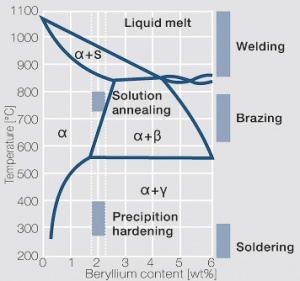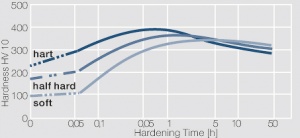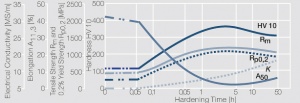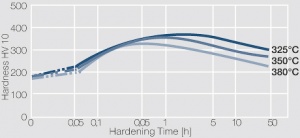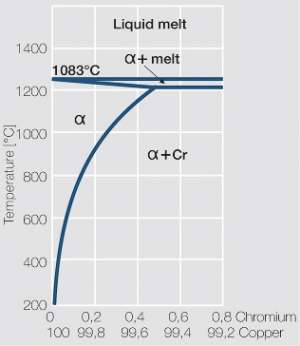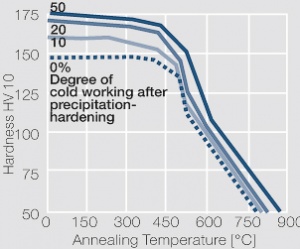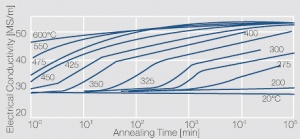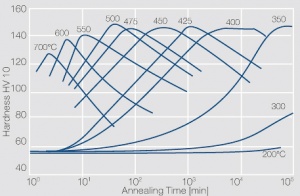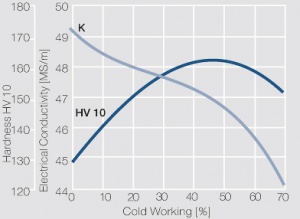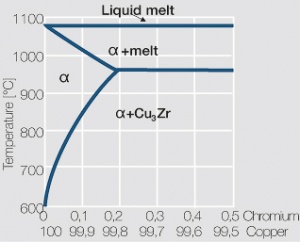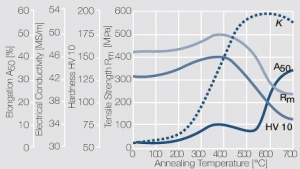Difference between revisions of "Aushärtbare Kupfer-Legierungen"
Teitscheid (talk | contribs) (temp edit) |
Doduco Admin (talk | contribs) (→Kupfer-Chrom-Legierungen) |
||
| (17 intermediate revisions by 2 users not shown) | |||
| Line 10: | Line 10: | ||
Temperatur rasch abnehmende Löslichkeit des Berylliums im Kupfer. Wie aus | Temperatur rasch abnehmende Löslichkeit des Berylliums im Kupfer. Wie aus | ||
dem Zustandsschaubild für CuBe ersichtlich, sind bei ca. 780°C 2,4 Massen-% | dem Zustandsschaubild für CuBe ersichtlich, sind bei ca. 780°C 2,4 Massen-% | ||
| − | Be in Kupfer löslich <xr id="fig:Phase_diagram_of_copperberyllium_with_temperature_ranges_for_brazing_and_annealing_treatments"/><!--(Fig. 5.28)-->. In diesem Temperaturbereich wärmebehandelte | + | Be in Kupfer löslich (<xr id="fig:Phase_diagram_of_copperberyllium_with_temperature_ranges_for_brazing_and_annealing_treatments"/><!--(Fig. 5.28)-->). In diesem Temperaturbereich wärmebehandelte |
CuBe-Legierungen sind homogen („lösungsglühen“). Der homogene Zustand | CuBe-Legierungen sind homogen („lösungsglühen“). Der homogene Zustand | ||
kann durch schnelles Abkühlen auf Raumtemperatur eingefroren werden („abschrecken“). | kann durch schnelles Abkühlen auf Raumtemperatur eingefroren werden („abschrecken“). | ||
| Line 16: | Line 16: | ||
von 325°C wird die gewünschte Ausscheidungshärtung erreicht, die einen | von 325°C wird die gewünschte Ausscheidungshärtung erreicht, die einen | ||
deutlichen Anstieg der Festigkeit und der elektrischen Leitfähigkeit von CuBe | deutlichen Anstieg der Festigkeit und der elektrischen Leitfähigkeit von CuBe | ||
| − | bewirkt <xr id="tab:Physical_Properties_of_Selected_Copper_Beryllium_Alloys"/><!--(Tab. 5.17)-->. Die erreichbaren Festigkeits- und Härtewerte sind abhängig | + | bewirkt (<xr id="tab:Physical_Properties_of_Selected_Copper_Beryllium_Alloys"/><!--(Tab. 5.17)-->). Die erreichbaren Festigkeits- und Härtewerte sind abhängig |
| − | von der Glühtemperatur und Glühdauer sowie vom Umformgrad ( | + | von der Glühtemperatur und Glühdauer sowie vom Umformgrad |
| − | <xr id="tab:Mechanical Properties of Selected Copper-Beryllium Alloys"/> | + | (<xr id="tab:Mechanical Properties of Selected Copper-Beryllium Alloys"/> und [[#figures7|Figs. 2 – 4)]]<!--(Figs. 5.29 - 5.31)-->. |
| Line 39: | Line 39: | ||
Kupfer-Legierungen ohne toxische bzw. deklarationspfichtige | Kupfer-Legierungen ohne toxische bzw. deklarationspfichtige | ||
Elemente z.B. CuNiCoSi zielt in Richtung CuBe-Ersatz. | Elemente z.B. CuNiCoSi zielt in Richtung CuBe-Ersatz. | ||
| − | |||
| − | |||
| − | |||
| − | |||
| − | |||
| − | |||
| − | |||
| − | |||
| − | |||
| − | |||
| − | |||
<div class="multiple-images"> | <div class="multiple-images"> | ||
| Line 62: | Line 51: | ||
<figure id="fig:Precipitation_hardening_of_CuBe2_(soft)_at_325°C"> | <figure id="fig:Precipitation_hardening_of_CuBe2_(soft)_at_325°C"> | ||
| − | [[File:Precipitation hardening of CuBe2 (soft) at 325C.jpg|left|thumb|<caption> | + | [[File:Precipitation hardening of CuBe2 (soft) at 325C.jpg|left|thumb|<caption>Aushärtung von CuBe2 (weich) bei 325°C</caption>]] |
</figure> | </figure> | ||
<figure id="fig:Precipitation_hardening_of_CuBe2_(half hard)_at_different_annealing_temperatures"> | <figure id="fig:Precipitation_hardening_of_CuBe2_(half hard)_at_different_annealing_temperatures"> | ||
| − | [[File:Precipitation hardening of CuBe2 half hard.jpg|left|thumb|<caption> | + | [[File:Precipitation hardening of CuBe2 half hard.jpg|left|thumb|<caption>Aushärtung von CuBe2 (halbhart) bei verschiedenen Anlasstemperaturen</caption>]] |
</figure> | </figure> | ||
</div> | </div> | ||
| Line 73: | Line 62: | ||
<figtable id="tab:Physical_Properties_of_Selected_Copper_Beryllium_Alloys"> | <figtable id="tab:Physical_Properties_of_Selected_Copper_Beryllium_Alloys"> | ||
| − | <caption>'''<!--Table 5.17:--> | + | <caption>'''<!--Table 5.17:-->Physikalische Eigenschaften einiger Kupfer-Beryllium-Legierungen'''</caption> |
{| class="twocolortable" style="text-align: left; font-size: 12px" | {| class="twocolortable" style="text-align: left; font-size: 12px" | ||
|- | |- | ||
| − | ! | + | !Werkstoff Bezeichnung<br />EN UNS |
| − | ! | + | !Zusammensetzung<br />[Massen-%] |
| − | ! | + | !Dichte<br />[g/cm<sup>3</sup>] |
| − | !colspan="2" style="text-align:center"| | + | !colspan="2" style="text-align:center"|Elektr. Leitfähigkeit |
| − | ! | + | !Elektr. Widerstand<br />[μΩ·cm] |
| − | ! | + | !Wärmeleitfähigkeit<br />[W/(m·K)] |
| − | ! | + | !Lin. Ausdehnungskoeff.<br />[10<sup>-6</sup>/K] |
| − | ! | + | !E-Modul<br />[GPa] |
| − | ! | + | !Erweichungstemperatur<br />(ca. 10% Festigkeitsabfall)<br />[°C] |
| − | ! | + | !Schmelzbereich<br />[°C] |
|- | |- | ||
! | ! | ||
| Line 103: | Line 92: | ||
|Be 1.6 - 1.8<br />Co 0.3<br />Ni 0.3<br />Cu Rest | |Be 1.6 - 1.8<br />Co 0.3<br />Ni 0.3<br />Cu Rest | ||
|8.4 | |8.4 | ||
| − | |8 - 9<sup>a</sup><br />12 - 13<sup>b</sup><br />11<sup>c</sup> | + | |8 - 9[[#text-reference1|<sup>a</sup>]]<br />12 - 13[[#text-reference2|<sup>b</sup>]]<br />11[[#text-reference3|<sup>c</sup>]] |
|14 - 16<br />21 - 22<br />19 | |14 - 16<br />21 - 22<br />19 | ||
| − | |11 - 12.5<sup>a</sup><br />7.7 - 8.3<sup>b</sup><br />9.1<sup>c</sup> | + | |11 - 12.5[[#text-reference1|<sup>a</sup>]]<br />7.7 - 8.3[[#text-reference2|<sup>b</sup>]]<br />9.1[[#text-reference3|<sup>c</sup>]] |
|110 | |110 | ||
|17 | |17 | ||
| − | |125<sup>a</sup><br />135<sup>b</sup> | + | |125[[#text-reference1|<sup>a</sup>]]<br />135[[#text-reference2|<sup>b</sup>]] |
|ca. 380 | |ca. 380 | ||
|890 - 1000 | |890 - 1000 | ||
| Line 115: | Line 104: | ||
|Be 1.8 - 2.1<br />Co 0.3<br />Ni 0.3<br />Cu Rest | |Be 1.8 - 2.1<br />Co 0.3<br />Ni 0.3<br />Cu Rest | ||
|8.3 | |8.3 | ||
| − | |8 - 9<sup>a</sup><br />12 - 13<sup>b</sup><br />11<sup>c</sup> | + | |8 - 9[[#text-reference1|<sup>a</sup>]]<br />12 - 13[[#text-reference2|<sup>b</sup>]]<br />11[[#text-reference3|<sup>c</sup>]] |
|14 - 16<br />21 - 22<br />19 | |14 - 16<br />21 - 22<br />19 | ||
| − | |11 - 12.5<sup>a</sup><br />7.7 - 8.3<sup>b</sup><br />9.1<sup>c</sup> | + | |11 - 12.5[[#text-reference1|<sup>a</sup>]]<br />7.7 - 8.3[[#text-reference2|<sup>b</sup>]]<br />9.1[[#text-reference3|<sup>c</sup>]] |
|110 | |110 | ||
|17 | |17 | ||
| − | |125<sup>a</sup><br />135<sup>b</sup> | + | |125[[#text-reference1|<sup>a</sup>]]<br />135[[#text-reference2|<sup>b</sup>]] |
|ca. 380 | |ca. 380 | ||
|870 - 980 | |870 - 980 | ||
| Line 127: | Line 116: | ||
|Co 2.0 - 2.8<br />Be 0.4 - 0.7<br />Ni 0.3<br />Cu Rest | |Co 2.0 - 2.8<br />Be 0.4 - 0.7<br />Ni 0.3<br />Cu Rest | ||
|8.8 | |8.8 | ||
| − | |11 - 14<sup>a</sup><br />25 - 27<sup>b</sup><br />27 - 34<sup>c</sup> | + | |11 - 14[[#text-reference1|<sup>a</sup>]]<br />25 - 27[[#text-reference2|<sup>b</sup>]]<br />27 - 34[[#text-reference3|<sup>c</sup>]] |
|19 - 24<br />43 - 47<br />47 - 59 | |19 - 24<br />43 - 47<br />47 - 59 | ||
| − | |7.1 - 9.1<sup>a</sup><br />3.7 - 4.0<sup>b</sup><br />2.9<sup>c</sup> | + | |7.1 - 9.1[[#text-reference1|<sup>a</sup>]]<br />3.7 - 4.0[[#text-reference2|<sup>b</sup>]]<br />2.9[[#text-reference3|<sup>c</sup>]] |
|210 | |210 | ||
|18 | |18 | ||
| − | |131<sup>a</sup><br />138<sup>b</sup> | + | |131[[#text-reference1|<sup>a</sup>]]<br />138[[#text-reference2|<sup>b</sup>]] |
|ca. 450 | |ca. 450 | ||
|1030 - 1070 | |1030 - 1070 | ||
| Line 139: | Line 128: | ||
|Ni 1.4 - 2.2<br />Be 0.2 - 0.6<br />Co 0.3<br />Cu Rest | |Ni 1.4 - 2.2<br />Be 0.2 - 0.6<br />Co 0.3<br />Cu Rest | ||
|8.8 | |8.8 | ||
| − | |11 - 14<sup>a</sup><br />25 - 27<sup>b</sup><br />27 - 34<sup>c</sup> | + | |11 - 14[[#text-reference1|<sup>a</sup>]]<br />25 - 27[[#text-reference2|<sup>b</sup>]]<br />27 - 34[[#text-reference3|<sup>c</sup>]] |
|19 - 24<br />43 - 47<br />47 - 59 | |19 - 24<br />43 - 47<br />47 - 59 | ||
| − | |7.1 - 9.1<sup>a</sup><br />3.7 - 4.0<sup>b</sup><br />2.9<sup>c</sup> | + | |7.1 - 9.1[[#text-reference1|<sup>a</sup>]]<br />3.7 - 4.0[[#text-reference2|<sup>b</sup>]]<br />2.9[[#text-reference3|<sup>c</sup>]] |
|230 | |230 | ||
|18 | |18 | ||
| − | |131<sup>a</sup><br />138<sup>b</sup> | + | |131[[#text-reference1|<sup>a</sup>]]<br />138[[#text-reference2|<sup>b</sup>]] |
|ca. 480 | |ca. 480 | ||
|1060 - 1100 | |1060 - 1100 | ||
|} | |} | ||
| + | <div id="text-reference1"><sub>a</sub> lösungsgeglüht und kaltumgeformt</div> | ||
| + | <div id="text-reference2"><sub>b</sub> lösungsgeglüht, kaltumgeformt und ausscheidungsgehärtet</div> | ||
| + | <div id="text-reference3"><sub>c</sub> lösungsgeglüht, kaltumgeformt und ausscheidungsgehärtet im Werk (werksvergütet)</div> | ||
</figtable> | </figtable> | ||
| − | + | <br/> | |
| − | + | <br/> | |
| − | |||
| − | |||
<figtable id="tab:Mechanical Properties of Selected Copper-Beryllium Alloys"> | <figtable id="tab:Mechanical Properties of Selected Copper-Beryllium Alloys"> | ||
| − | <caption>'''<!--Table 5.18:--> | + | <caption>'''<!--Table 5.18:-->Mechanische Eigenschaften von Kupfer-Beryllium-Legierungen'''</caption> |
{| class="twocolortable" style="text-align: left; font-size: 12px" | {| class="twocolortable" style="text-align: left; font-size: 12px" | ||
|- | |- | ||
| − | ! | + | !Werkstoff |
| − | ! | + | !Zustand |
| − | ! | + | !Zugfestigkeit R<sub>m</sub><br />[MPa] |
| − | !0,2% | + | !0,2% Dehngrenze<br />R<sub>p02</sub><br />[MPa] |
| − | ! | + | !Bruchdehnung<br />A<sub>50</sub><br />[%] |
| − | ! | + | !Vickershärte<br />HV |
| − | ! | + | !Biegeradius[[#text-reference4|<sup>1</sup>]]<br />min senkrecht zur<br />Walzrichtung |
| − | ! | + | !Biegeradius[[#text-reference4|<sup>1</sup>]]<br />min parallel zur<br />Walzrichtung |
| − | ! | + | !Federbiegegrenze<br />σ<sub>FB</sub><br />[MPa] |
| − | ! | + | !Biegewechselfestigkeit<br />σ<sub>BW</sub><br />[MPa] |
|- | |- | ||
|CuBe1,7 | |CuBe1,7 | ||
| − | |R 390<sup>a</sup><br />R 680<sup>a</sup><br />R 1030<sup>b</sup><br />R 1240<sup>b</sup><br />R 680<sup>c</sup><br />R 1100<sup>c</sup> | + | |R 390[[#text-reference5|<sup>a</sup>]]<br />R 680[[#text-reference5|<sup>a</sup>]]<br />R 1030[[#text-reference6|<sup>b</sup>]]<br />R 1240[[#text-reference6|<sup>b</sup>]]<br />R 680[[#text-reference7|<sup>c</sup>]]<br />R 1100[[#text-reference7|<sup>c</sup>]] |
|380 -520<br />680 - 820<br />1030 - 1240<br />1240 - 1380<br />680 - 750<br />1100 - 1200 | |380 -520<br />680 - 820<br />1030 - 1240<br />1240 - 1380<br />680 - 750<br />1100 - 1200 | ||
|≥ 180<br />≥ 600<br />≥ 900<br />≥ 1070<br />≥ 480<br />≥ 930 | |≥ 180<br />≥ 600<br />≥ 900<br />≥ 1070<br />≥ 480<br />≥ 930 | ||
| Line 183: | Line 173: | ||
|- | |- | ||
|CuBe2 | |CuBe2 | ||
| − | |R 410<sup>a</sup><br />R 690<sup>a</sup><br />R 1140<sup>b</sup><br />R 1310<sup>b</sup><br />R 690<sup>c</sup><br />R 1200<sup>c</sup> | + | |R 410[[#text-reference5|<sup>a</sup>]]<br />R 690[[#text-reference5|<sup>a</sup>]]<br />R 1140[[#text-reference6|<sup>b</sup>]]<br />R 1310[[#text-reference6|<sup>b</sup>]]<br />R 690[[#text-reference7|<sup>c</sup>]]<br />R 1200[[#text-reference7|<sup>c</sup>]] |
|410 -540<br />690 - 820<br />1140 - 1310<br />1310 - 1480<br />690 - 760<br />1200 - 1320 | |410 -540<br />690 - 820<br />1140 - 1310<br />1310 - 1480<br />690 - 760<br />1200 - 1320 | ||
|≥ 190<br />≥ 650<br />≥ 1000<br />≥ 1150<br />≥ 480<br />≥ 1030 | |≥ 190<br />≥ 650<br />≥ 1000<br />≥ 1150<br />≥ 480<br />≥ 1030 | ||
| Line 194: | Line 184: | ||
|- | |- | ||
|CuCo2Be<br />CuNi2Be | |CuCo2Be<br />CuNi2Be | ||
| − | |R 250<sup>a</sup><br />R 550<sup>a</sup><br />R 650<sup>b</sup><br />R 850<sup>b</sup><br />R 520<sup>c</sup> | + | |R 250[[#text-reference5|<sup>a</sup>]]<br />R 550[[#text-reference5|<sup>a</sup>]]<br />R 650[[#text-reference6|<sup>b</sup>]]<br />R 850[[#text-reference6|<sup>b</sup>]]<br />R 520[[#text-reference7|<sup>c</sup>]] |
|250 - 380<br />550 - 700<br />650 - 820<br />850 - 1000<br />520 - 620 | |250 - 380<br />550 - 700<br />650 - 820<br />850 - 1000<br />520 - 620 | ||
|≥ 140<br />≥ 450<br />≥ 520<br />≥ 750<br />≥ 340 | |≥ 140<br />≥ 450<br />≥ 520<br />≥ 750<br />≥ 340 | ||
| Line 204: | Line 194: | ||
| <br /> <br />220<br />250<br />210 | | <br /> <br />220<br />250<br />210 | ||
|} | |} | ||
| − | < | + | <div id="text-reference4"><sub>1</sub> t: Banddicke max 0,5 mm</div> |
| − | < | + | <div id="text-reference5"><sub>a</sub> lösungsgeglüht und kaltumgeformt</div> |
| − | < | + | <div id="text-reference6"><sub>b</sub> lösungsgeglüht, kaltumgeformt und ausscheidungsgehärtet</div> |
| − | < | + | <div id="text-reference7"><sub>c</sub> lösungsgeglüht, kaltumgeformt und ausscheidungsgehärtet im Werk (werksvergütet)</div> |
| − | < | + | </figtable> |
| − | + | <br/> | |
| − | + | <br/> | |
| − | |||
| − | |||
| − | + | ====<!--5.1.6.2-->Weitere aushärtbare Kupfer-Legierungen==== | |
| − | + | =====<!--5.1.6.2.1-->Kupfer-Chrom-Legierungen===== | |
| − | < | + | Kupfer-Chrom ist, wie das Zustandsdiagramm zeigt, ähnlich wie Kupfer- |
| + | Beryllium aushärtbar (<xr id="fig:Copper corner of the copper-chromium phase diagram for up to 0.8 wt% chromium"/><!--(Fig. 5.32)-->). Im ausgehärteten Zustand ist CuCr begrenzt | ||
| + | kaltumformbar. Es weist gegenüber Kupfer eine stark erhöhte Warmfestigkeit | ||
| + | bei hoher elektrischer Leitfähigkeit auf. Härte und elektrische Leitfähigkeit von | ||
| + | Kupfer-Chrom in Abhängigkeit von der Kaltumformung und den Aushärtebedingungen | ||
| + | sind in Figure [[#figures8|6 bis 9]]<!--Figs. 5.33 und 5.35--> dargestellt (<xr id="tab:Physical Properties of Other Precipitation Hardening Copper Alloys"/><!--(Tables 5.19)--> und <xr id="tab:Mechanical Properties of Other Precipitation Hardening Copper Alloys"/><!--(Tab. 5.20)-->). | ||
| − | + | Kupfer-Chrom-Werkstoffe eignen sich besonders für Widerstands-Schweißelektroden. | |
| − | + | Beim Hartlöten tritt nur ein geringer Härteabfall auf, wenn mit | |
| − | + | niedrigschmelzenden Silberloten und kurzer Lötzeit gearbeitet wird. | |
| − | |||
| − | |||
| − | |||
| − | |||
| − | |||
| − | |||
| − | |||
<div class="multiple-images"> | <div class="multiple-images"> | ||
<figure id="fig:Copper corner of the copper-chromium phase diagram for up to 0.8 wt% chromium"> | <figure id="fig:Copper corner of the copper-chromium phase diagram for up to 0.8 wt% chromium"> | ||
| − | [[File:Copper corner of the copper chromium phase diagram.jpg|left|thumb|<caption> | + | [[File:Copper corner of the copper chromium phase diagram.jpg|left|thumb|<caption>Kupferecke des Zustandsdiagramms Kupfer-Chrom bis 0,8 Massen-% Chrom</caption>]] |
</figure> | </figure> | ||
<figure id="fig:Softening of precipitation hardened and subsequently cold worked CuCr1"> | <figure id="fig:Softening of precipitation hardened and subsequently cold worked CuCr1"> | ||
| − | [[File:Softening of precipitation hardened and subsequently cold worked CuCr1.jpg|left|thumb|<caption> | + | [[File:Softening of precipitation hardened and subsequently cold worked CuCr1.jpg|left|thumb|<caption>Erweichungsverhalten von warmausgehärtetem und nachverformtem CuCr1</caption>]] |
</figure> | </figure> | ||
<figure id="fig:Electrical conductivity of precipitation hardened CuCr 0.6"> | <figure id="fig:Electrical conductivity of precipitation hardened CuCr 0.6"> | ||
| − | [[File:Electrical conductivity of precipitation hardened CuCr 0.6.jpg|left|thumb|<caption> | + | [[File:Electrical conductivity of precipitation hardened CuCr 0.6.jpg|left|thumb|<caption>Abhängigkeit der elektrischen Leitfähigkeit von lösungsgeglühtem CuCr0,6 von der Glühbehandlung</caption>]] |
</figure> | </figure> | ||
<figure id="fig:Hardness of precipitation hardened CuCr 0.6"> | <figure id="fig:Hardness of precipitation hardened CuCr 0.6"> | ||
| − | [[File:Hardness of precipitation hardened CuCr 0.6.jpg|left|thumb|<caption> | + | [[File:Hardness of precipitation hardened CuCr 0.6.jpg|left|thumb|<caption>Abhängigkeit der Härte von lösungsgeglühtem CuCr 0,6 von der Glühbehandlung</caption>]] |
</figure> | </figure> | ||
<figure id="fig:Electrical conductivity and hardness of precipitation hardened CuCr 0.6"> | <figure id="fig:Electrical conductivity and hardness of precipitation hardened CuCr 0.6"> | ||
| − | [[File:Electrical conductivity and hardness of precipitation hardened CuCr 0.6.jpg|left|thumb|<caption> | + | [[File:Electrical conductivity and hardness of precipitation hardened CuCr 0.6.jpg|left|thumb|<caption>Elektrische Leitfähigkeit und Härte von warmausgehärtetem CuCr 0,6 nach Kaltumformung</caption>]] |
</figure> | </figure> | ||
</div> | </div> | ||
| Line 257: | Line 243: | ||
<figtable id="tab:Physical Properties of Other Precipitation Hardening Copper Alloys"> | <figtable id="tab:Physical Properties of Other Precipitation Hardening Copper Alloys"> | ||
| − | <caption>'''<!--Table 5.19:--> | + | <caption>'''<!--Table 5.19:-->Physikalische Eigenschaften weiterer aushärtbarer Kupfer-Legierungen'''</caption> |
{| class="twocolortable" style="text-align: left; font-size: 12px" | {| class="twocolortable" style="text-align: left; font-size: 12px" | ||
|- | |- | ||
| − | ! | + | !Werkstoff Bezeichnung<br />EN UNS |
| − | ! | + | !Zusammensetzung<br />[Massen-%] |
| − | ! | + | !Dichte<br />[g/cm<sup>3</sup>] |
| − | !colspan="2" style="text-align:center"| | + | !colspan="2" style="text-align:center"|Elektr. Leitfähigkeit |
| − | ! | + | !Elektr. Widerstand<br />[μΩ·cm] |
| − | ! | + | !Wärmeleitfähigkeit<br />[W/(m·K)] |
| − | ! | + | !Lin. Ausdehnungskoeff.<br />[10<sup>-6</sup>/K] |
| − | ! | + | !E-Modul<br />[GPa] |
| − | ! | + | !Erweichungstemperatur<br />(ca. 10% Festigkeitsabfall)<br />[°C] |
| − | ! | + | !Schmelzbereich<br />[°C] |
|- | |- | ||
! | ! | ||
| Line 287: | Line 273: | ||
|Cr 0.3 - 1.2<br />Cu Rest | |Cr 0.3 - 1.2<br />Cu Rest | ||
|8.89 | |8.89 | ||
| − | |26<sup>a</sup><br />48<sup>b</sup> | + | |26[[#text-reference8|<sup>a</sup>]]<br />48[[#text-reference9|<sup>b</sup>]] |
| − | |45<sup>a</sup><br />83<sup>b</sup> | + | |45[[#text-reference8|<sup>a</sup>]]<br />83[[#text-reference9|<sup>b</sup>]] |
| − | |3.8<sup>a</sup><br />2.1<sup>b</sup> | + | |3.8[[#text-reference8|<sup>a</sup>]]<br />2.1[[#text-reference9|<sup>b</sup>]] |
| − | |170<sup>a</sup><br />315<sup>b</sup> | + | |170[[#text-reference8|<sup>a</sup>]]<br />315[[#text-reference9|<sup>b</sup>]] |
|17 | |17 | ||
|112 | |112 | ||
| Line 299: | Line 285: | ||
|Zr 0.1 - 0.3<br />Cu Rest | |Zr 0.1 - 0.3<br />Cu Rest | ||
|8.9 | |8.9 | ||
| − | |35<sup>a</sup><br />52<sup>b</sup> | + | |35[[#text-reference8|<sup>a</sup>]]<br />52[[#text-reference9|<sup>b</sup>]] |
| − | |60<sup>a</sup><br />90<sup>b</sup> | + | |60[[#text-reference8|<sup>a</sup>]]<br />90[[#text-reference9|<sup>b</sup>]] |
| − | |2.9<sup>a</sup><br />1.9<sup>b</sup> | + | |2.9[[#text-reference8|<sup>a</sup>]]<br />1.9[[#text-reference9|<sup>b</sup>]] |
| − | |340<sup>a</sup> | + | |340[[#text-reference8|<sup>a</sup>]] |
|16 | |16 | ||
|135 | |135 | ||
| Line 311: | Line 297: | ||
|Cr 0.5 - 1.2<br />Zr 0.03 - 0.3<br />Cu Rest | |Cr 0.5 - 1.2<br />Zr 0.03 - 0.3<br />Cu Rest | ||
|8.92 | |8.92 | ||
| − | |20<sup>a</sup><br />43<sup>b</sup> | + | |20[[#text-reference8|<sup>a</sup>]]<br />43[[#text-reference9|<sup>b</sup>]] |
| − | |34<sup>a</sup><br />74<sup>b</sup> | + | |34[[#text-reference8|<sup>a</sup>]]<br />74[[#text-reference9|<sup>b</sup>]] |
| − | |5.0<sup>a</sup><br />2.3<sup>b</sup> | + | |5.0[[#text-reference8|<sup>a</sup>]]<br />2.3[[#text-reference9|<sup>b</sup>]] |
| − | |170<sup>a</sup><br />310 - 330<sup>b</sup> | + | |170[[#text-reference8|<sup>a</sup>]]<br />310 - 330[[#text-reference9|<sup>b</sup>]] |
|16 | |16 | ||
| − | |110<sup>a</sup><br />130<sup>b</sup> | + | |110<sup>a</sup><br />130[[#text-reference9|<sup>b</sup>]] |
|ca. 500 | |ca. 500 | ||
|1070 - 1080 | |1070 - 1080 | ||
|} | |} | ||
| + | <div id="text-reference8"><sub>a</sub> lösungsgeglüht und kaltumgeformt</div> | ||
| + | <div id="text-reference9"><sub>b</sub> lösungsgeglüht, kaltumgeformt und ausscheidungsgehärtet</div> | ||
</figtable> | </figtable> | ||
| − | + | <br /> | |
| − | + | <br /> | |
| − | |||
<figtable id="tab:Mechanical Properties of Other Precipitation Hardening Copper Alloys"> | <figtable id="tab:Mechanical Properties of Other Precipitation Hardening Copper Alloys"> | ||
| − | <caption>'''<!--Table 5.20:--> | + | <caption>'''<!--Table 5.20:-->Mechanische Eigenschaften weiterer aushärtbarer Kupfer-Legierungen'''</caption> |
<table class="twocolortable"> | <table class="twocolortable"> | ||
| − | <tr><th><p class="s16"> | + | <tr><th><p class="s16">Werkstoff</p></th><th><p class="s16">Zustand</p></th><th><p class="s16">Zugfestigkeit</p><p class="s16">R<span class="s18">m</span></p><p class="s16">[MPa]</p></th><th><p class="s16">0,2% Dehngrenze</p><p class="s16">R<span class="s18">p02</span></p><p class="s16">[MPa]</p></th><th><p class="s16">Bruchdehnung</p><p class="s16">A50</p><p class="s16">[%]</p></th><th><p class="s16">Vickershärte</p><p class="s16">HV</p></th><th><p class="s16">Federbiegegrenze</p><p class="s16"><span class="s19">F</span><span class="s18">FB </span>[MPa]</p></th></tr><tr><td><p class="s16">CuCr</p></td><td><p class="s16">R 230<span class="s18">a</span></p><p class="s16">R 400<span class="s18">a </span>R 450<span class="s18">b </span>R 550<span class="s18">b</span></p></td><td><p class="s33">><span class="s16"> 230</span></p><p class="s33">><span class="s16"> 400</span></p><p class="s33">><span class="s16"> 450</span></p><p class="s33">><span class="s16"> 550</span></p></td><td><p class="s33">><span class="s16"> 80</span></p><p class="s33">><span class="s16"> 295</span></p><p class="s33">><span class="s16"> 325</span></p><p class="s33">><span class="s16"> 440</span></p></td><td><p class="s16">30</p><p class="s16">10</p><p class="s16">10</p><p class="s16">8</p></td><td><p class="s33">><span class="s16"> 55</span></p><p class="s33">><span class="s16"> 120</span></p><p class="s33">><span class="s16"> 130</span></p><p class="s33">><span class="s16"> 150</span></p></td><td><p class="s16">350</p></td></tr><tr><td><p class="s16">CuZr</p></td><td><p class="s16">R 260<span class="s18">a</span></p><p class="s16">R 370<span class="s18">a </span>R 400<span class="s18">b </span>R 420<span class="s18">b</span></p></td><td><p class="s33">><span class="s16"> 260</span></p><p class="s33">><span class="s16"> 370</span></p><p class="s33">><span class="s16"> 400</span></p><p class="s33">><span class="s16"> 420</span></p></td><td><p class="s33">><span class="s16"> 100</span></p><p class="s33">><span class="s16"> 270</span></p><p class="s33">><span class="s16"> 280</span></p><p class="s33">><span class="s16"> 400</span></p></td><td><p class="s16">35</p><p class="s16">12</p><p class="s16">12</p><p class="s16">10</p></td><td><p class="s33">><span class="s16"> 55</span></p><p class="s33">><span class="s16"> 100</span></p><p class="s33">><span class="s16"> 105</span></p><p class="s33">><span class="s16"> 115</span></p></td><td><p class="s16">280</p></td></tr><tr><td><p class="s16">CuCr1Zr</p></td><td><p class="s16">R 200<span class="s18">a</span></p><p class="s16">R 400<span class="s18">b</span></p><p class="s16">R 450<span class="s18">b</span></p></td><td><p class="s33">><span class="s16"> 200</span></p><p class="s33">><span class="s16"> 400</span></p><p class="s33">><span class="s16"> 450</span></p></td><td><p class="s33">><span class="s16"> 60</span></p><p class="s33">><span class="s16"> 210</span></p><p class="s33">><span class="s16"> 360</span></p></td><td><p class="s16">30</p><p class="s16">12</p><p class="s16">10</p></td><td><p class="s33">><span class="s16"> 70</span></p><p class="s33">><span class="s16"> 140</span></p><p class="s33">><span class="s16"> 155</span></p></td><td><p class="s16">420</p></td></tr></table> |
</figtable> | </figtable> | ||
| − | =====<!--5.1.6.2.2--> | + | =====<!--5.1.6.2.2-->Kupfer-Zirkon-Legierungen===== |
| − | |||
| − | |||
| − | |||
| − | |||
| − | + | Die Löslichkeit von Zirkon in Kupfer beträgt ca. 0,15 Massen-% Zr bei der | |
| + | eutektischen Temperatur von 980° C (<xr id="fig:Copper corner of the copper zirconium for up to 0.5-wt zirconium"/><!--(Fig. 5.36)-->). Kupfer-Zirkon-Werkstoffe weisen | ||
| + | ein ähnliches Eigenschaftsspektrum wie die Kupfer-Chrom-Werkstoffe auf. Bei | ||
| + | Raumtemperatur ist Kupfer-Zirkon in den mechanischen Eigenschaften dem | ||
| + | Kupfer-Chrom unterlegen, bezüglich Warmfestigkeit jedoch mindestens | ||
| + | gleichwertig. | ||
| − | + | =====<!--5.1.6.2.3-->Kupfer-Chrom-Zirkon-Legierungen===== | |
| − | <xr id="fig:Softening of CuCr1Zr after 1hr annealing"/><!-- | + | Anstatt der früher üblichen Werkstoffe CuCr und CuZr wird seit einigen Jahren die |
| + | aushärtbare Dreistofflegierung CuCr1Zr eingesetzt. Dieser Werkstoff zeichnet sich | ||
| + | durch hohe Festigkeitswerte auch bei erhöhten Temperaturen und eine sehr hohe | ||
| + | Anlaufbeständigkeit sowie hohe Erweichungstemperaturen aus. Im ausgehärteten | ||
| + | Zustand weist CuCr1Zr eine hohe elektrische Leitfähigkeit auf (<xr id="fig:Softening of CuCr1Zr after 1hr annealing"/><!--(Bild 5.37)-->). | ||
| + | Neben ihrem Einsatz als mechanisch und thermisch hochbeanspruchbare Teile, | ||
| + | z.B. als Kontakttulpen in Hochspannungsschaltern, ist auch ihre Verwendung als | ||
| + | Elektrodenwerkstoffe für das Widerstandsschweißen hervorzuheben. | ||
<div class="multiple-images"> | <div class="multiple-images"> | ||
<figure id="fig:Copper corner of the copper zirconium for up to 0.5-wt zirconium"> | <figure id="fig:Copper corner of the copper zirconium for up to 0.5-wt zirconium"> | ||
| − | [[File:Copper corner of the copper zirconium for up to 0.5-wt zirconium.jpg|right|thumb| | + | [[File:Copper corner of the copper zirconium for up to 0.5-wt zirconium.jpg|right|thumb|Figure 10: Kupferecke des Zustandsdiagramms Kupfer-Zirkon bis 0,5 Massen-% Zirkon]] |
</figure> | </figure> | ||
<figure id="fig:Softening of CuCr1Zr after 1hr annealing"> | <figure id="fig:Softening of CuCr1Zr after 1hr annealing"> | ||
| − | [[File:Softening of CuCr1Zr after 1hr annealing.jpg|right|thumb| | + | [[File:Softening of CuCr1Zr after 1hr annealing.jpg|right|thumb|Figure 11: Erweichungsverhalten von CuCr1Zr nach 1h Glühdauer und einer Kaltumformung von 90%]] |
</figure> | </figure> | ||
</div> | </div> | ||
Latest revision as of 09:22, 12 January 2023
Neben den naturharten Kupferwerkstoffen spielen aushärtbare Kupferlegierungen als Trägerwerkstoffe für elektrische Kontakte eine wichtige Rolle. Bei den aushärtbaren Legierungen können durch eine geeignete Wärmebehandlung fein verteilte Ausscheidungen einer zweiten Phase erzeugt werden, die die Festigkeit des Werkstoffes deutlich erhöhen.
Contents
Kupfer-Beryllium-Legierungen (Berylliumbronze)
Voraussetzung für die Aushärtbarkeit der CuBe-Werkstoffe ist die mit sinkender Temperatur rasch abnehmende Löslichkeit des Berylliums im Kupfer. Wie aus dem Zustandsschaubild für CuBe ersichtlich, sind bei ca. 780°C 2,4 Massen-% Be in Kupfer löslich (Figure 1). In diesem Temperaturbereich wärmebehandelte CuBe-Legierungen sind homogen („lösungsglühen“). Der homogene Zustand kann durch schnelles Abkühlen auf Raumtemperatur eingefroren werden („abschrecken“). Durch die anschließende Wärmebehandlung bei einer Temperatur von 325°C wird die gewünschte Ausscheidungshärtung erreicht, die einen deutlichen Anstieg der Festigkeit und der elektrischen Leitfähigkeit von CuBe bewirkt (Table 1). Die erreichbaren Festigkeits- und Härtewerte sind abhängig von der Glühtemperatur und Glühdauer sowie vom Umformgrad (Table 2 und Figs. 2 – 4).
Von den aushärtbaren Kupferlegierungen haben CuBe-Werkstoffe, vor allem
CuBe2 und CuBe1,7 für stromführende Kontaktfedern wegen ihrer herausragenden
mechanischen Eigenschaften eine besondere Bedeutung erlangt.
Daneben sind noch die Werkstoffe CuCo2Be und CuNi2Be zu erwähnen, die
bei mittleren Festigkeitswerten eine relativ hohe elektrische Leitfähigkeit
aufweisen.
CuBe-Legierungen sind als aushärtbare Halbzeuge in verschiedenen Lieferzuständen
erhältlich. Daneben können CuBe-Halbzeuge mit geringen Einbußen
hinsichtlich der Festigkeitseigenschaften im „werksvergüteten“ Zustand eingesetzt
werden. In diesem Falle wurde das Halbzeug bereits beim Hersteller
ausscheidungsgehärtet.
Da Beryllium in der EU-67/548 als kanzerogen eingestuft ist, wird bei einer Reihe von Legierungen versucht, das Eigenschaftsspektrum der bewährten CuBe1,7- und CuBe2-Werkstoffe wenigstens näherungsweise auch mit einem geringeren Be-Anteil zu erreichen. Auch die Entwicklung weiterer ausscheidungshärtender Kupfer-Legierungen ohne toxische bzw. deklarationspfichtige Elemente z.B. CuNiCoSi zielt in Richtung CuBe-Ersatz.
| Werkstoff Bezeichnung EN UNS |
Zusammensetzung [Massen-%] |
Dichte [g/cm3] |
Elektr. Leitfähigkeit | Elektr. Widerstand [μΩ·cm] |
Wärmeleitfähigkeit [W/(m·K)] |
Lin. Ausdehnungskoeff. [10-6/K] |
E-Modul [GPa] |
Erweichungstemperatur (ca. 10% Festigkeitsabfall) [°C] |
Schmelzbereich [°C] | |
|---|---|---|---|---|---|---|---|---|---|---|
| [MS/m] | [% IACS] | |||||||||
| CuBe1.7 CW100C C17000 |
Be 1.6 - 1.8 Co 0.3 Ni 0.3 Cu Rest |
8.4 | 8 - 9a 12 - 13b 11c |
14 - 16 21 - 22 19 |
11 - 12.5a 7.7 - 8.3b 9.1c |
110 | 17 | 125a 135b |
ca. 380 | 890 - 1000 |
| CuBe2 CW101C C17200 |
Be 1.8 - 2.1 Co 0.3 Ni 0.3 Cu Rest |
8.3 | 8 - 9a 12 - 13b 11c |
14 - 16 21 - 22 19 |
11 - 12.5a 7.7 - 8.3b 9.1c |
110 | 17 | 125a 135b |
ca. 380 | 870 - 980 |
| CuCo2Be CW104C C17500 |
Co 2.0 - 2.8 Be 0.4 - 0.7 Ni 0.3 Cu Rest |
8.8 | 11 - 14a 25 - 27b 27 - 34c |
19 - 24 43 - 47 47 - 59 |
7.1 - 9.1a 3.7 - 4.0b 2.9c |
210 | 18 | 131a 138b |
ca. 450 | 1030 - 1070 |
| CuNi2Be CW110C C17510 |
Ni 1.4 - 2.2 Be 0.2 - 0.6 Co 0.3 Cu Rest |
8.8 | 11 - 14a 25 - 27b 27 - 34c |
19 - 24 43 - 47 47 - 59 |
7.1 - 9.1a 3.7 - 4.0b 2.9c |
230 | 18 | 131a 138b |
ca. 480 | 1060 - 1100 |
| Werkstoff | Zustand | Zugfestigkeit Rm [MPa] |
0,2% Dehngrenze Rp02 [MPa] |
Bruchdehnung A50 [%] |
Vickershärte HV |
Biegeradius1 min senkrecht zur Walzrichtung |
Biegeradius1 min parallel zur Walzrichtung |
Federbiegegrenze σFB [MPa] |
Biegewechselfestigkeit σBW [MPa] |
|---|---|---|---|---|---|---|---|---|---|
| CuBe1,7 | R 390a R 680a R 1030b R 1240b R 680c R 1100c |
380 -520 680 - 820 1030 - 1240 1240 - 1380 680 - 750 1100 - 1200 |
≥ 180 ≥ 600 ≥ 900 ≥ 1070 ≥ 480 ≥ 930 |
35 2 3 1 18 3 |
80 - 135 210 - 250 330 - 380 360 - 420 220 - 350 330 - 370 |
0 x t 1 x t 1 x t 1 x t 6 x t |
0 x t 3 x t 1.5 x t 1 x t 10 x t |
700 1000 390 790 |
260 280 260 |
| CuBe2 | R 410a R 690a R 1140b R 1310b R 690c R 1200c |
410 -540 690 - 820 1140 - 1310 1310 - 1480 690 - 760 1200 - 1320 |
≥ 190 ≥ 650 ≥ 1000 ≥ 1150 ≥ 480 ≥ 1030 |
35 2 3 1 18 3 |
90 - 140 215 - 260 350 - 400 380 - 450 220 - 250 360 - 410 |
0 x t 1 x t 1 x t 5 x t |
0 x t 3 x t 1.5 x t 10 x t |
800 1040 400 900 |
270 300 280 |
| CuCo2Be CuNi2Be |
R 250a R 550a R 650b R 850b R 520c |
250 - 380 550 - 700 650 - 820 850 - 1000 520 - 620 |
≥ 140 ≥ 450 ≥ 520 ≥ 750 ≥ 340 |
20 2 10 1 5 |
60 - 90 160 - 200 195 - 230 240 - 290 150 - 180 |
0 x t 3 x t 1 x t 3 x t 1 x t |
0 x t 1 x t 3.5 x t 1 x t |
360 650 300 |
220 250 210 |
Weitere aushärtbare Kupfer-Legierungen
Kupfer-Chrom-Legierungen
Kupfer-Chrom ist, wie das Zustandsdiagramm zeigt, ähnlich wie Kupfer- Beryllium aushärtbar (Figure 5). Im ausgehärteten Zustand ist CuCr begrenzt kaltumformbar. Es weist gegenüber Kupfer eine stark erhöhte Warmfestigkeit bei hoher elektrischer Leitfähigkeit auf. Härte und elektrische Leitfähigkeit von Kupfer-Chrom in Abhängigkeit von der Kaltumformung und den Aushärtebedingungen sind in Figure 6 bis 9 dargestellt (Table 3 und Table 4).
Kupfer-Chrom-Werkstoffe eignen sich besonders für Widerstands-Schweißelektroden. Beim Hartlöten tritt nur ein geringer Härteabfall auf, wenn mit niedrigschmelzenden Silberloten und kurzer Lötzeit gearbeitet wird.
| Werkstoff Bezeichnung EN UNS |
Zusammensetzung [Massen-%] |
Dichte [g/cm3] |
Elektr. Leitfähigkeit | Elektr. Widerstand [μΩ·cm] |
Wärmeleitfähigkeit [W/(m·K)] |
Lin. Ausdehnungskoeff. [10-6/K] |
E-Modul [GPa] |
Erweichungstemperatur (ca. 10% Festigkeitsabfall) [°C] |
Schmelzbereich [°C] | |
|---|---|---|---|---|---|---|---|---|---|---|
| [MS/m] | [% IACS] | |||||||||
| CuCr | Cr 0.3 - 1.2 Cu Rest |
8.89 | 26a 48b |
45a 83b |
3.8a 2.1b |
170a 315b |
17 | 112 | ca. 450 | 980 - 1080 |
| CuZr | Zr 0.1 - 0.3 Cu Rest |
8.9 | 35a 52b |
60a 90b |
2.9a 1.9b |
340a | 16 | 135 | ca. 500 | 1020 - 1080 |
| CuCr1Zr CW106C C18150 |
Cr 0.5 - 1.2 Zr 0.03 - 0.3 Cu Rest |
8.92 | 20a 43b |
34a 74b |
5.0a 2.3b |
170a 310 - 330b |
16 | 110a 130b |
ca. 500 | 1070 - 1080 |
Werkstoff | Zustand | Zugfestigkeit Rm [MPa] | 0,2% Dehngrenze Rp02 [MPa] | Bruchdehnung A50 [%] | Vickershärte HV | Federbiegegrenze FFB [MPa] |
|---|---|---|---|---|---|---|
CuCr | R 230a R 400a R 450b R 550b | > 230 > 400 > 450 > 550 | > 80 > 295 > 325 > 440 | 30 10 10 8 | > 55 > 120 > 130 > 150 | 350 |
CuZr | R 260a R 370a R 400b R 420b | > 260 > 370 > 400 > 420 | > 100 > 270 > 280 > 400 | 35 12 12 10 | > 55 > 100 > 105 > 115 | 280 |
CuCr1Zr | R 200a R 400b R 450b | > 200 > 400 > 450 | > 60 > 210 > 360 | 30 12 10 | > 70 > 140 > 155 | 420 |
Kupfer-Zirkon-Legierungen
Die Löslichkeit von Zirkon in Kupfer beträgt ca. 0,15 Massen-% Zr bei der eutektischen Temperatur von 980° C (Figure 10). Kupfer-Zirkon-Werkstoffe weisen ein ähnliches Eigenschaftsspektrum wie die Kupfer-Chrom-Werkstoffe auf. Bei Raumtemperatur ist Kupfer-Zirkon in den mechanischen Eigenschaften dem Kupfer-Chrom unterlegen, bezüglich Warmfestigkeit jedoch mindestens gleichwertig.
Kupfer-Chrom-Zirkon-Legierungen
Anstatt der früher üblichen Werkstoffe CuCr und CuZr wird seit einigen Jahren die aushärtbare Dreistofflegierung CuCr1Zr eingesetzt. Dieser Werkstoff zeichnet sich durch hohe Festigkeitswerte auch bei erhöhten Temperaturen und eine sehr hohe Anlaufbeständigkeit sowie hohe Erweichungstemperaturen aus. Im ausgehärteten Zustand weist CuCr1Zr eine hohe elektrische Leitfähigkeit auf (Figure 11). Neben ihrem Einsatz als mechanisch und thermisch hochbeanspruchbare Teile, z.B. als Kontakttulpen in Hochspannungsschaltern, ist auch ihre Verwendung als Elektrodenwerkstoffe für das Widerstandsschweißen hervorzuheben.
